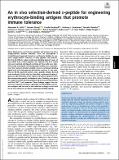Notice
This is not the latest version of this item. The latest version can be found at:https://dspace.mit.edu/handle/1721.1/133529.2
An in vivo selection-derived d-peptide for engineering erythrocyte-binding antigens that promote immune tolerance
| dc.contributor.author | Loftis, Alexander R | |
| dc.contributor.author | Zhang, Genwei | |
| dc.contributor.author | Backlund, Coralie | |
| dc.contributor.author | Quartararo, Anthony J | |
| dc.contributor.author | Pishesha, Novalia | |
| dc.contributor.author | Hanna, Cameron C | |
| dc.contributor.author | Schissel, Carly K | |
| dc.contributor.author | Garafola, Daniel | |
| dc.contributor.author | Loas, Andrei | |
| dc.contributor.author | Collier, R John | |
| dc.contributor.author | Ploegh, Hidde | |
| dc.contributor.author | Irvine, Darrell J | |
| dc.contributor.author | Pentelute, Bradley L | |
| dc.date.accessioned | 2021-10-27T19:53:22Z | |
| dc.date.available | 2021-10-27T19:53:22Z | |
| dc.date.issued | 2021-08-24 | |
| dc.identifier.uri | https://hdl.handle.net/1721.1/133529 | |
| dc.description.abstract | <jats:p>When displayed on erythrocytes, peptides and proteins can drive antigen-specific immune tolerance. Here, we investigated a straightforward approach based on erythrocyte binding to promote antigen-specific tolerance to both peptides and proteins. We first identified a robust erythrocyte-binding ligand. A pool of one million fully <jats:sc>d</jats:sc>-chiral peptides was injected into mice, blood cells were isolated, and ligands enriched on these cells were identified using nano-liquid chromatography–tandem mass spectrometry. One round of selection yielded a murine erythrocyte-binding ligand with an 80 nM apparent dissociation constant, <jats:italic>K</jats:italic><jats:sub>d</jats:sub>. We modified an 83-kDa bacterial protein and a peptide antigen derived from ovalbumin (OVA) with the identified erythrocyte-binding ligand. An administration of the engineered bacterial protein led to decreased protein-specific antibodies in mice. Similarly, mice given the engineered OVA-derived peptide had decreased inflammatory anti-OVA CD8<jats:sup>+</jats:sup> T cell responses. These findings suggest that our tolerance-induction strategy is applicable to both peptide and protein antigens and that our in vivo selection strategy can be used for de novo discovery of robust erythrocyte-binding ligands.</jats:p> | en_US |
| dc.language.iso | en | |
| dc.publisher | Proceedings of the National Academy of Sciences | en_US |
| dc.relation.isversionof | 10.1073/pnas.2101596118 | en_US |
| dc.rights | Article is made available in accordance with the publisher's policy and may be subject to US copyright law. Please refer to the publisher's site for terms of use. | en_US |
| dc.source | PNAS | en_US |
| dc.title | An in vivo selection-derived d-peptide for engineering erythrocyte-binding antigens that promote immune tolerance | en_US |
| dc.type | Article | en_US |
| dc.relation.journal | Proceedings of the National Academy of Sciences | en_US |
| dc.eprint.version | Final published version | en_US |
| dc.type.uri | http://purl.org/eprint/type/JournalArticle | en_US |
| eprint.status | http://purl.org/eprint/status/PeerReviewed | en_US |
| dc.date.updated | 2021-09-03T16:42:18Z | |
| dspace.orderedauthors | Loftis, AR; Zhang, G; Backlund, C; Quartararo, AJ; Pishesha, N; Hanna, CC; Schissel, CK; Garafola, D; Loas, A; Collier, RJ; Ploegh, H; Irvine, DJ; Pentelute, BL | en_US |
| dspace.date.submission | 2021-09-03T16:42:22Z | |
| mit.journal.volume | 118 | en_US |
| mit.journal.issue | 34 | en_US |
| mit.license | PUBLISHER_POLICY | |
| mit.metadata.status | Authority Work and Publication Information Needed | en_US |
| mit.metadata.status | Authority Work and Publication Information Needed |
